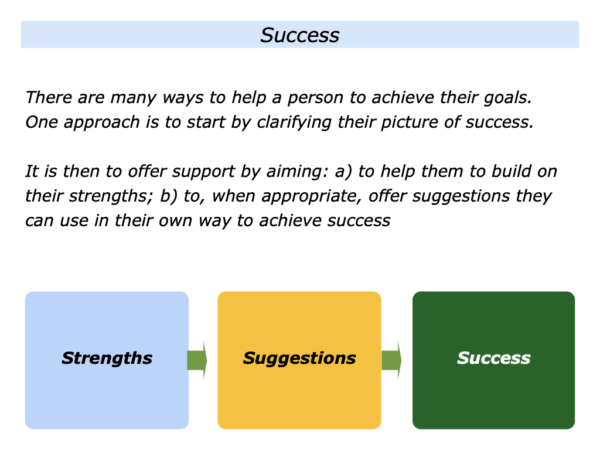
There are many ways to help people to achieve their goals. One approach is to start by clarifying their picture of success. It is then to then offer support by aiming:
To help them to build on their strengths:
To, when appropriate, offer suggestions they can use in their own way to achieve success.
Such an approach is encouraging but also gives a reality check. It can help people to continue to do what they do well and also tackle areas for improvement.
Imagine that a person has asked for your help in working towards achieving a goal. You can help them to focus on the following themes.
Success
The first step is to clarify their aims. One approach is to say something along the following lines.
“Looking to the future, what are your short and longer-term goals? What are the real results you want to achieve? What is your picture of success? What will be the benefits of achieving the picture of success?”
The person may want to achieve many things, of course, so it can be useful to list these in order of priority. As a reminder, you may then want to summarise the person’s goals in the following way.
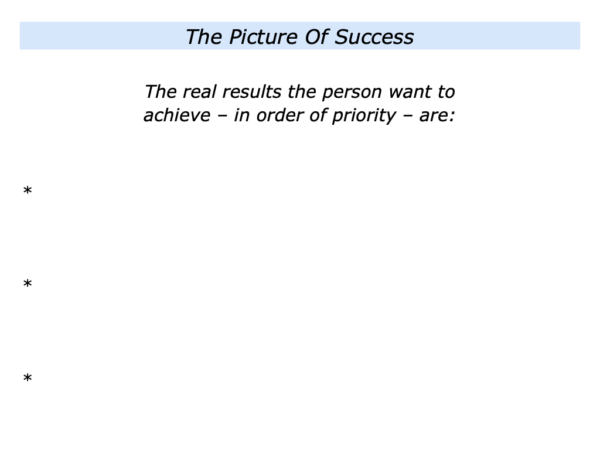
Let’s assume that you have followed elements of this approach. When appropriate, you may then move on to the next stage.
As mentioned earlier, this involves offering support. It is to help them to build on the strengths and, when appropriate, to offer suggestions they can use in their own way to achieve success. Let’s explore these themes.
Strengths
Imagine that you are clear on the person’s goals. The next step is to focus on the strengths they can use to achieve their aims. There are several themes you can explore at this stage.
The first theme to focus on is what they are doing well. Bearing in mind the results they want to achieve, you can explore the following questions.
What is the person’s strengths? What are they doing right that will help them to achieve their goals? What are the principles they are following? How are they translating these into action? What are the specific examples of them doing these things?
How can I encourage the person to build on these strengths? What are the key messages I can give them about what they are doing well? How can I bring these to life with specific examples? How can I encourage them to do more of these things?
The second theme is to focus on the person’s positive history. Looking at their past, it is to explore when they have tackled similar challenges or achieved similar goals successfully.
The most effective approach is to explore these themes with the person. On other occasions, however, you may need to explore their background and use your imagination. When doing so, you can ask the following questions.
What is the person’s positive history? What is their successful pattern? Looking back, when have they tackled a similar challenge or achieved a similar goal successfully?
What did the person do right then? What were the principles they followed? How did they translate these into action? How can they follow similar principles – plus maybe add other skills – in the future?
Imagine that you have explored some of these themes. If appropriate, you can list your findings in the following way.
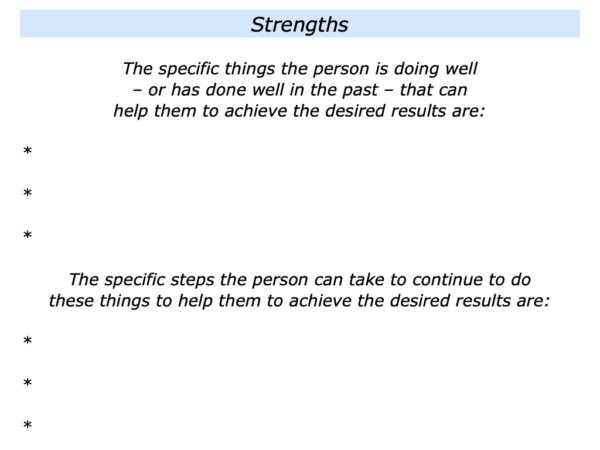
Let’s assume that you have followed elements of this approach in your own way. When appropriate, you may then move on to the next stage.
Suggestions
Imagine that you have clarified what the person is doing well that can help them to achieve their goals. The next step is:
To clarify what the person can do better – and how – to help them achieve their aims;
To clarify the knowledge and practical tools you can pass on to help them achieve their aims;
To clarify how you can pass on these suggestions and ideas in a way they can accept and use to achieve their aims.
How to take these steps? One approach is to explore the following themes.
What can the person do better – and how – to help them to achieve their goals? What can they do to increase the chances of success? What are the specific things they can add to their repertoire?
What are the positive models and practical tools I can pass on? How can I pass on this knowledge in a way that resonates with the person? How can I do this in way they can accept and use to achieve their goals?
Imagine that you have explored some of these themes. If appropriate, you can list your findings in the following way.
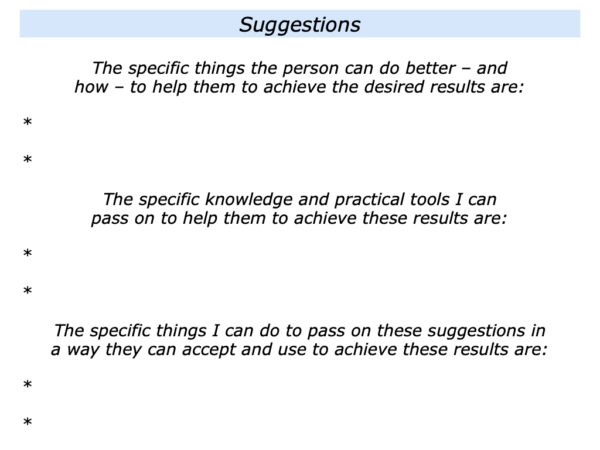
Let’s assume that you have followed elements of this approach in your own way. When appropriate, you may then move on to the next stage.
Success
Imagine that you have clarified the results the person wants to achieve. You have also explored the specific things they can do: a) to build on their strengths; b) to increase their chances of achieving their goals.
The next step is to have a conversation with the person about how they can continue to work towards achieving their goals. Before doing so, however, it can be useful for them to do a piece of prework.
This involves them developing the habit of self-development. If appropriate, you can invite them to do the following exercise.
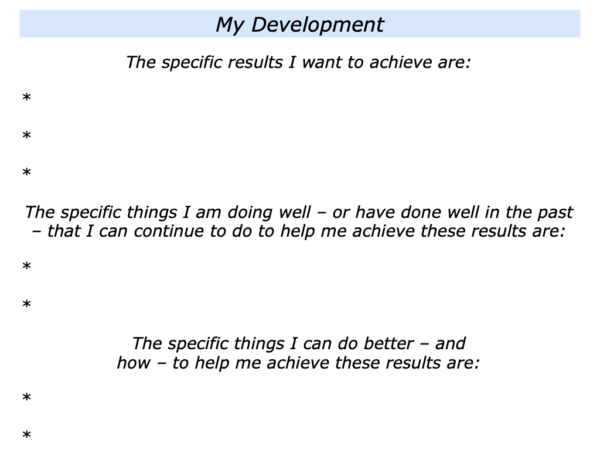
Imagine that the person has done this exercise. It is important to give them the opportunity to talk through what they have written. This approach can provide an insight into a person’s mindset.
Some people may be good at clarifying their strengths and areas for improvement. Some may be overly self-critical. Some may talk in generalisations or have a particular view of reality.
Imagine that the person has described their self-evaluation and given some specific examples. When appropriate, you may then say something along the following lines.
“Looking at what you have said, I think you are spot on in the following areas you mention. For example:
*
*
*
“Bearing in mind the goals you want to achieve, is it okay to share some ideas you may be able to use in your own way?”
The person will probably say yes, but it is important to get their psychological permission. This helps to create the environment where they are open to ideas.
Imagine that they have taken this step. If appropriate, you may want to say something along the following lines.
“Let’s go back to the goals you want to achieve. As far as I understand it, you want to:
*
*
*
“Bearing these goals in mind, here are some ideas you may want to use to build on your strengths.
“One possibility is to … For example to …
“Another possibility is to … For example to …
Imagine that you are following this approach in your own way. As mentioned earlier, it can be important to ask yourself the following questions.
What are the key messages I want to give to the person? How can I put these in a way that resonates with them? How can I pass on these ideas in a way they can accept and use to achieve their goals?
Let’s assume you are sharing some ideas. When doing so, it can be useful to look for those that are resonating with the person. You can then explore these in greater depth.
Sometimes it is easy to see which ideas are resonating but this is not always the case with introverts. At some point you may therefore want to create a time out where a person can clarify their thoughts.
Imagine that you have shared some specific ideas regarding how the person can build on their strengths. You may then focus on what they can do better – or what they can add to their repertoire – to improve their chances of achieving their goals.
Sometimes it can be more challenging for a person to focus on what they can improve. Bearing this in mind, you may want to say something along the following lines.
“Looking ahead, would it be okay to share some ideas you can use to increase your chances of achieving your goals? You can take the ideas you like and use them in your own way.”
Let’s assume the person has said they would like you to share these ideas. If appropriate, you may say something along the following lines in your own way.
“Looking at the first goal you want to achieve, here are some possible ways forward. But again you would need to apply these in your own way.
“One possibility you may want to consider is to …
“For example to …”
It is up to you how many of the person’s goals you focus on and the number of practical ideas you share. The key is to make the session relevant and rewarding for the person.
There will come a point, however, where you recognise the person feels they have enough ideas. They may then want to move on to translating some of these into action.
There are then several options. Some people may prefer to take time to reflect before making an action plan. Some may want to do this on the spot.
Each person will have their own approach to making an action plan. The key, however, is for them to make a plan that they believe in. One approach is for them to do something like the following exercise.
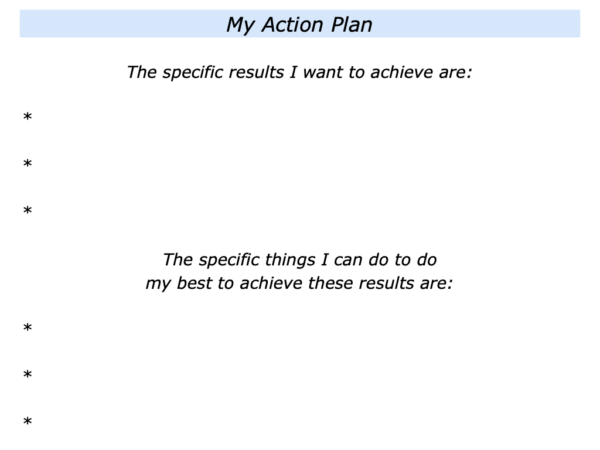
There are many ways to help people to develop. One approach is to clarify the results they want to achieve. It is then to help them to build on their strengths and offer suggestions they can use to achieve success.
Let’s return to your own work. Looking ahead, can you think of a situation where you may want to follow elements of this approach? How can you follow this in your own way?
If you wish, try tackling the exercise on this theme. This invites to complete the following sentences.
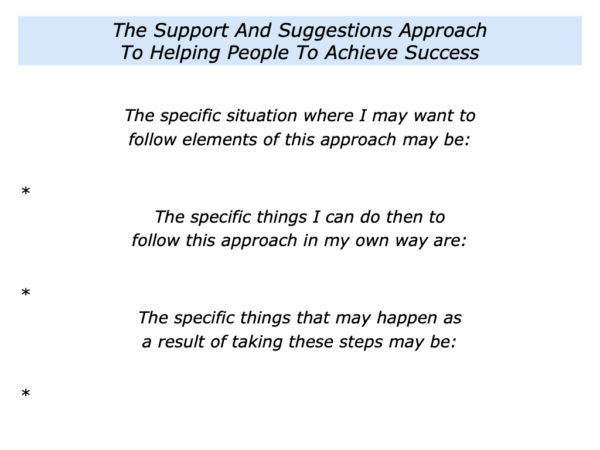






Leave a Reply